By ROY ROBERTSON
Council Project Manager

Polar Tankers, Inc. conducted the annual Prince William Sound shipper’s drill for 2013 on October 7-9. Polar Tankers is the shipping company owned by ConocoPhillips.
This large drill involved more than 700 participants and included command posts in both Valdez and Anchorage as well as field activities in Prince William Sound.
The scenario had a Polar Tankers ship colliding with two barges being towed in tandem close to Montague Point on Montague Island in Prince William Sound.
New drill features
This drill included some unique features not normally included in the annual exercises in Prince William Sound:
- The location of the simulated oil spill and scenario was not released to the drill participants until the start of the drill. In most drills, the scenario is known or developed by members of the response team.
- This drill scenario used actual weather and currents, and included activation of two open water barge taskforces and two sensitive area protection task forces. Many drills used pre-scripted weather to provide certainty of where the oil spill will go.
- The drill ran continuously, around the clock, for 48 hours.
- The Valdez command post transitioned to a command post in Anchorage.
The use of actual weather played a big role in this drill. While tugs, barges, and fishing vessels were sent to deploy oil spill response equipment in the area of the simulated spill, no equipment could be deployed due primarily to weather conditions at the spill site during these few days. The weather also precluded the use of simulated aerial dispersant applications.
This exercise confirmed that there are conditions when oil spill response activities cannot be performed as planned at the spill site. In fact, no simulated oil was recovered during this drill.
This exercise included not only a transition of command from Alyeska to Polar Tankers, but also a transition of command posts from Valdez to Anchorage. This transition occurred earlier than it could realistically be implemented during an actual spill response. Preplanning allowed the Anchorage command post to be set up prior to the start of the spill response. However, it is likely that at some point during a major spill response in Prince William Sound or the Gulf of Alaska a similar transition of command post would occur. The weather also played a role in the transition of the command post by forcing the response team members to go by road to Anchorage instead of flying.
Lessons learned
This drill provided many lessons for those involved.
First, the weather will dictate spill response actions that can be used. If weather does not permit response activities in the immediate area of the spill, response organizations need to focus on spill response measures that can be accomplished in other areas.
Because the drill continued through the night, industry companies, agencies and other organizations involved with this exercise were pushed to the limit regarding numbers of personnel available to perform their roles. This is realistic as everyone involved with a spill response will be scrambling to cover all of the bases.
Another lesson identified during this exercise is that while the transition of command posts will likely occur, this transition needs to be well-thought-out and should not occur until the separate command posts are functioning concurrently before the formal transition occurs from one to the other.
For more information about this drill, contact Roy Robertson.